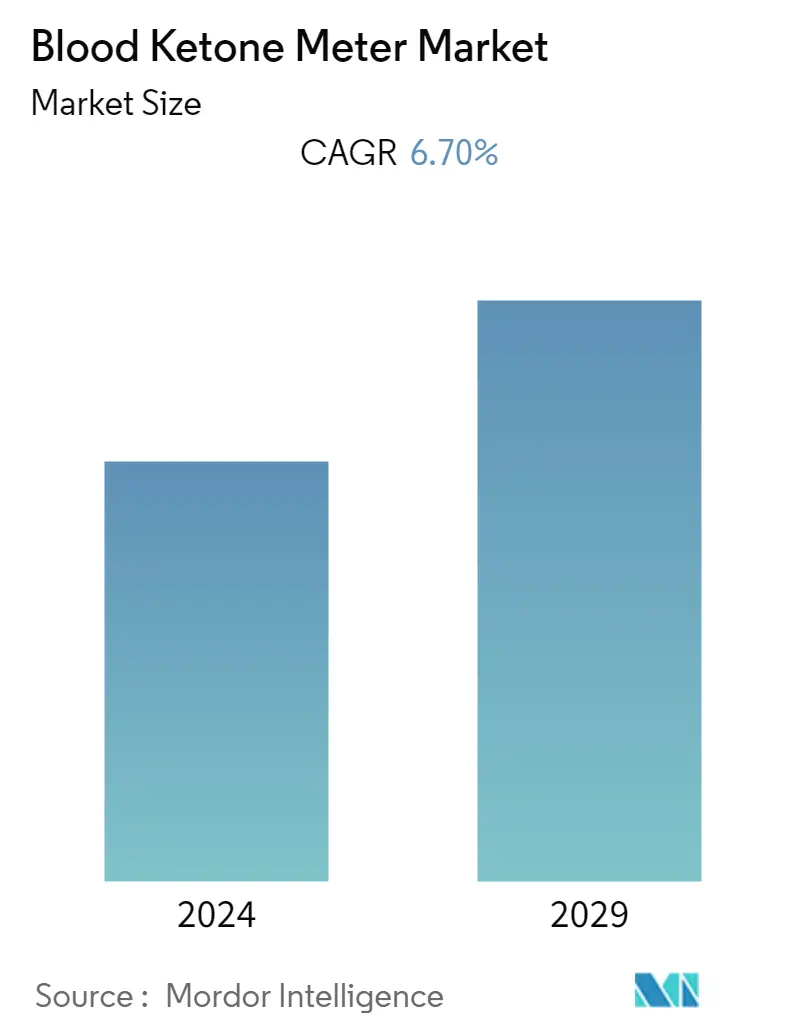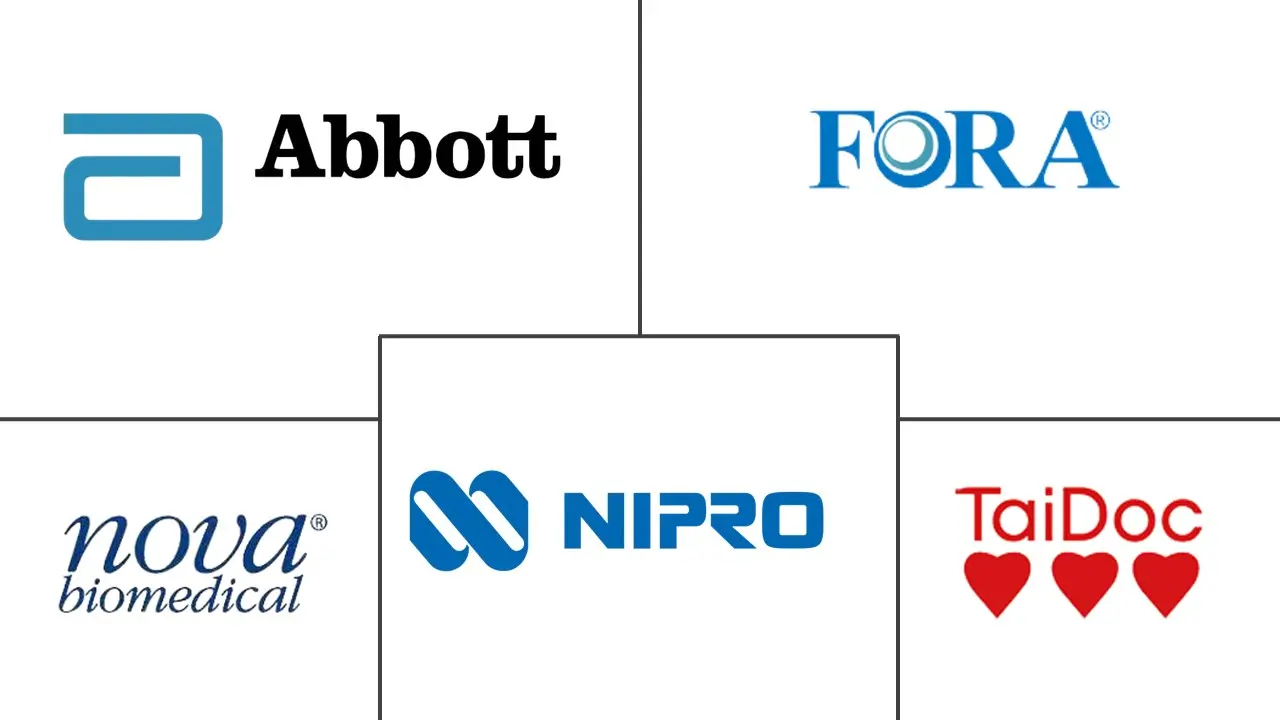Market Size of Blood Ketone Meter Industry

| Study Period | 2019 - 2029 |
| Base Year For Estimation | 2023 |
| Forecast Data Period | 2024 - 2029 |
| CAGR | 6.70 % |
| Fastest Growing Market | Asia-Pacific |
| Largest Market | North America |
Major Players
*Disclaimer: Major Players sorted in no particular order |
Blood Ketone Meter Market Analysis
The blood ketone meter market is projected to register a CAGR of 6.7% during the forecast period.
The COVID-19 pandemic had a significant impact on the market. An increase in the incidence of diabetes and rising complications in diabetic patients infected with COVID-19 are expected to drive market growth. For instance, according to an article published by The Lancet Diabetes & Endocrinology in December 2022, a population-level study of over 61 million people was conducted in England during the first wave of the pandemic, and it was reported that there was an increased risk for in-hospital COVID-19-related mortality in people with diabetes compared with people without diabetes. Thus the pandemic had a significant impact on the market growth initially. However, with the declining COVID-19 cases, the studied market is expected to regain its full potential over the years.
Factors such as the rising prevalence of diabetes and the increasing product launches and approvals are expected to boost market growth.
The rising prevalence of diabetes around the world is a major factor driving the market growth, as blood ketone meters are used for diabetes monitoring. For instance, according to the data updated by IDF in December 2021, it was estimated that approximately 537 million adults in the age group of 20-79 years were living with diabetes in 2021, and the total number of people living with diabetes is projected to rise to 643 million by 2030 and 783 million by 2045. The source also stated that 3 in 4 adults with diabetes live in low- and middle-income countries, and almost 1 in 2 people or 240 million adults were living with diabetes are undiagnosed diabetes in 2021. Thus, the high prevalence of diabetes around the world is expected to boost the adoption of blood ketone meters.
Moreover, according to an article published by PubMed Central in August 2022, it has been observed that the advent of point-of-care (POC) blood ketone monitors addresses the unmet need for reliable and expedient diabetes testing at home and in emergency settings. These devices sample capillary blood through a fingerstick and it provides the advantage of a quantitative, speedy measure of the main ketone B-OHB, in a device format familiar with self-monitoring of blood glucose. Thus, the rising advantages of blood ketone monitors are expected to boost market growth as well.
Additionally, the rising developments by major market players are also expected to enhance market growth. For instance, in April 2021, Nova Biomedical, a major manufacturer of blood ketone meters, announced that they are continuing their international expansion with a new sale, service, and distribution subsidiary in Benelux. The new facility reveals Nova Biomedical's continued growth in the European market. Also, in March 2021, EKF Diagnostics launched a Stat-Site WB handheld analyzer that delivers β-ketone and glucose measurements from whole blood in seconds. The device is used for the quantitative determination of β-ketones (Beta-Hydroxybutyrate or BHB) and glucose in whole blood taken from capillary or venous samples.
Thus, the aforementioned factors such as the rising prevalence of diabetes, the increasing advantages of blood ketone meters, and the rising developments by major market players are expected to enhance the market growth. However, the rising instances of product recalls are expected to hinder market growth.
Blood Ketone Meter Industry Segmentation
As per the scope of the report, a blood ketone meter is a device used to measure the level of ketones in the blood. Ketones are elements made by the body when it does not get enough glucose or blood sugar. Ketones can show up in urine or blood. High ketone levels may indicate diabetic ketoacidosis, a complication of diabetes that can lead to a coma or even death. Ketones in a blood test can prompt you to get treatment before a medical emergency occurs. The Blood Ketone Meter Market is Segmented by Product Type (Blood Ketone Monitoring, Blood Glucose and Ketone Monitoring, and Consumables), Application (Human and Veterinary), End User (Hospitals and Clinics, Diagnostic Centers, and Other End Users), and Geography (North America, Europe, Asia-Pacific, Middle East and Africa, and South America). The market report also covers the estimated market sizes and trends for 17 countries across major regions globally. The report offers the value (in USD million) for all the above segments.
| Product Type | |
| Blood Ketone Monitoring | |
| Blood Glucose and Ketone Monitoring | |
| Consumables |
| Application | |
| Human | |
| Veterinary |
| End User | |
| Hospitals and Clinics | |
| Diagnostic Centers | |
| Other End Users |
| Geography | ||||||||
| ||||||||
| ||||||||
| ||||||||
| ||||||||
|
Blood Ketone Meter Market Size Summary
The blood ketone meter market is poised for significant growth, driven by the increasing prevalence of diabetes and the rising demand for effective diabetes management solutions. The market is expected to experience a steady expansion over the forecast period, with key factors such as the growing incidence of diabetes worldwide and the introduction of innovative products playing a crucial role. The COVID-19 pandemic initially impacted the market, highlighting the vulnerabilities of diabetic patients and underscoring the importance of blood ketone monitoring. As the pandemic's effects wane, the market is anticipated to regain its momentum, supported by advancements in point-of-care devices that offer rapid and reliable testing capabilities. The market's growth is further bolstered by strategic developments from major players, who are expanding their global presence and enhancing product offerings to meet the evolving needs of consumers.
Regionally, North America holds a substantial share of the blood ketone meter market, attributed to the high prevalence of diabetes and a significant geriatric population. The region's market growth is fueled by ongoing innovations and developments by key industry players, who are investing in research and development to introduce technologically advanced solutions. The market landscape is moderately fragmented, with both major and minor players contributing to the competitive environment. As the demand for diabetes management tools continues to rise, the blood ketone meter market is expected to witness sustained growth, driven by the increasing awareness of diabetes-related complications and the need for effective monitoring solutions.
Blood Ketone Meter Market Size - Table of Contents
-
1. MARKET DYNAMICS
-
1.1 Market Overview
-
1.2 Market Drivers
-
1.2.1 Rising Prevalence of Diabetes
-
1.2.2 Increasing Product Launches and Approvals
-
-
1.3 Market Restraints
-
1.3.1 Rising Instances of Product Recalls
-
-
1.4 Porter's Five Forces Analysis
-
1.4.1 Threat of New Entrants
-
1.4.2 Bargaining Power of Buyers/Consumers
-
1.4.3 Bargaining Power of Suppliers
-
1.4.4 Threat of Substitute Products
-
1.4.5 Intensity of Competitive Rivalry
-
-
-
2. MARKET SEGMENTATION (Market Size by Value - USD million)
-
2.1 Product Type
-
2.1.1 Blood Ketone Monitoring
-
2.1.2 Blood Glucose and Ketone Monitoring
-
2.1.3 Consumables
-
-
2.2 Application
-
2.2.1 Human
-
2.2.2 Veterinary
-
-
2.3 End User
-
2.3.1 Hospitals and Clinics
-
2.3.2 Diagnostic Centers
-
2.3.3 Other End Users
-
-
2.4 Geography
-
2.4.1 North America
-
2.4.1.1 United States
-
2.4.1.2 Canada
-
2.4.1.3 Mexico
-
-
2.4.2 Europe
-
2.4.2.1 Germany
-
2.4.2.2 United Skingdom
-
2.4.2.3 France
-
2.4.2.4 Italy
-
2.4.2.5 Spain
-
2.4.2.6 Rest of Europe
-
-
2.4.3 Asia-Pacific
-
2.4.3.1 China
-
2.4.3.2 Japan
-
2.4.3.3 India
-
2.4.3.4 Australia
-
2.4.3.5 South Korea
-
2.4.3.6 Rest of Asia-Pacific
-
-
2.4.4 Middle East and Africa
-
2.4.4.1 GCC
-
2.4.4.2 South Africa
-
2.4.4.3 Rest of Middle East and Africa
-
-
2.4.5 South America
-
2.4.5.1 Brazil
-
2.4.5.2 Argentina
-
2.4.5.3 Rest of South America
-
-
-
Blood Ketone Meter Market Size FAQs
What is the current Blood Ketone Meter Market size?
The Blood Ketone Meter Market is projected to register a CAGR of 6.70% during the forecast period (2024-2029)
Who are the key players in Blood Ketone Meter Market?
Abbott Laboratories, Nova Biomedical, Nipro Corporation, TaiDoc technology Corporation and ForaCare, Inc. are the major companies operating in the Blood Ketone Meter Market.

